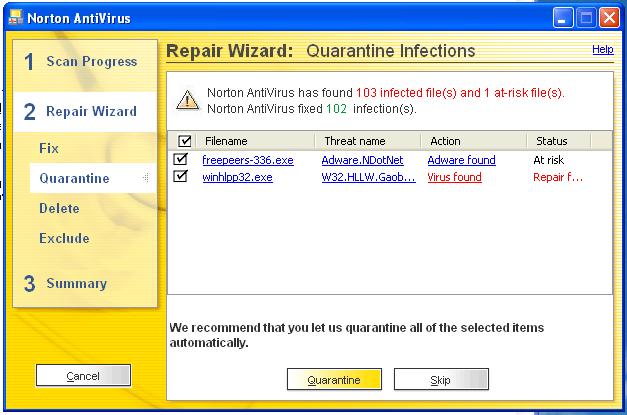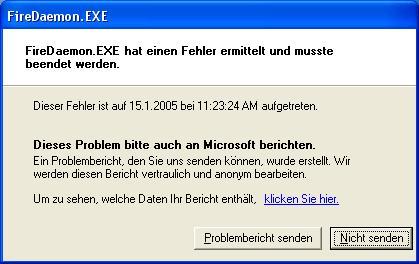My Favorite Micro$haft Windoze Screen Shots
The following images are screenshots from my Micro$haft
Windoze machine.
We bought a home computer from a store down the street
with Micro$haft Windoze XP pre-installed on it.
(In fact, we had no choice.
Niedermeyer offered
no choices at this time. It seems they are improving
however.)
What the screenshot below shows is a dialog communicating
to the user what software has been installed on the machine.
Since we bought the computer sometime around February/March
of 2002, there have been 30 "HotFix"s installed!
There was not enough screen real estate to capture them
all in one screenshot, but you get the idea.
As of now that is an average of about 2 per month!
Do we still have viruses? Yes we do. More on
this topic below.

.
This was one of my favorite viruses, the Blaster worm.
 .
.
At that time, we actually tried to follow Micro$haft's advice.
However, the problem was we had to download and install "Service
Pack 1" (one of the Shaft's "innovations") in order to accomplish
this, a task that required some hours of work.
However, whenever we tried to install Service Pack 1 on Windoze
XP, we got the
BLUE
SCREEN
OF
DEATH (BSOD)
on restart.
I thought they tried to get rid of the BSOD, but it's still around.
The result was that we couldn't fully boot the computer anymore.
Then we had to get out the original repair CD that came with the computer
to try and and get Windoze running again.
Basically, it reinstalls the version of Windoze that was on the
computer at the time we bought it.
However, the problem with that, is that the scores of
"Hot Fixes" that were installed previously, were all now removed.
Thus, we had to go to Windoze Update to reinstall all of the
security patches. And here is what the result
looked like a few hours later:
 .
.
An almost endless list of security patches etc. The
list is far to long to fit in one screen shot.
You might think that with all of these security patches,
we would be able to use our computer and maybe not
even have too many viruses -not even close, more below.
After some months, we still accumulated viruses.
Our computer stopped working properly.
Our broadband internet access slowed down to an unbearable crawl.
We knew we had viruses.
After screwing around with a couple of free anti-virus software
packages, which didn't work, we finally got a copy
of Norton Anti-Virus.
Norton Anti-Virus runs a virus scan from CD before it installs
itself.
Here's a copy of our scan
results.
We found 76 viruses and infected files.
Yes, that's right, 76!
This includes several instances of the "Blood Hound" virus.
It must have been a new world record.
But it doesn't end there.
Here's the screen shot from when we ran Norton Anti-Virus on
disk after it was installed with the latest virus profiles:
 .
.
ONE
HUNDRED
AND
THREE (103)
more viruses and infected files! Wow, two world records in
a row! And some of these viruses were sophisticated.
They would write new entries into the Windoze registry
(a problem that would not be allowed to happen on the Mac
or Linux) just like they had administrative privileges.
Then they would have themselves run automatically upon
startup, spreading themselves everytime we booted the computer
and opened a web connection.
The good news is, our internet access started working
again after running Norton Anti-virus.
Anyone know what this one is?
 .
.
We've been getting this great error message for like a year
now everytime we boot the computer.
It doesn't just appear once, but two-four times everytime
on startup.
It doesn't seem to matter how many patches or "Hot Fixes" we
install or how many virus programs we try, this error message
always appears.
It also doesn't matter how many times we send a "problem report".
I'm assuming it's a virus.
We've been using Red Hat Linux at work since 1998.
We've never installed any HotFix's and we have never had
a virus. In my 5 or so years as a Apple Mac owner, the
same holds true.
Someday, we will be able to use Linux at home too.
So far, we have not discovered support for our ADSL modem
connected via USB under Linux.
I long for the days when Micro$haft no longer holds such
a firm monopoly on the home desktop PC.

 .
.
 .
.
 .
.
 .
.